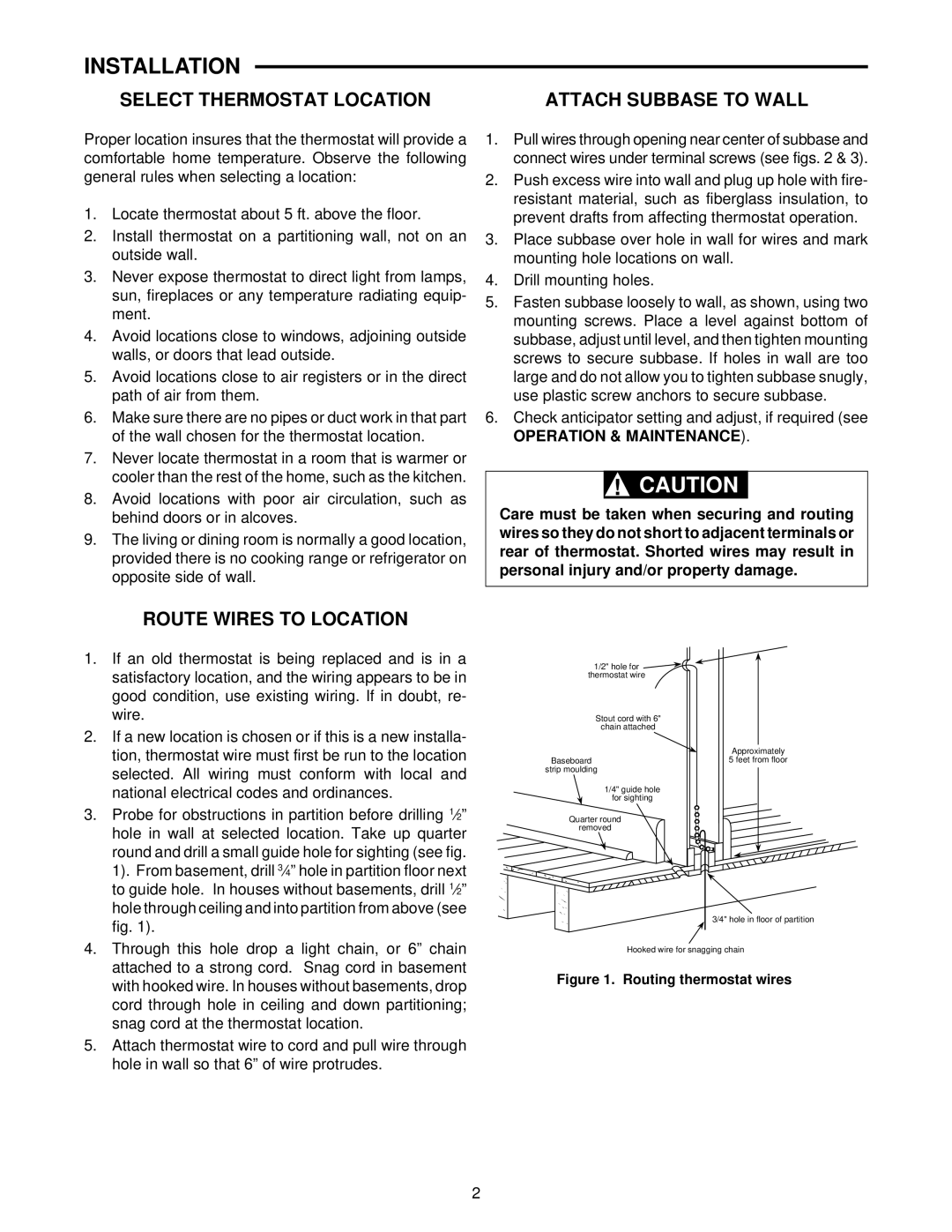
INSTALLATION
SELECT THERMOSTAT LOCATION | ATTACH SUBBASE TO WALL |
Proper location insures that the thermostat will provide a comfortable home temperature. Observe the following general rules when selecting a location:
1.Locate thermostat about 5 ft. above the floor.
2.Install thermostat on a partitioning wall, not on an outside wall.
3.Never expose thermostat to direct light from lamps, sun, fireplaces or any temperature radiating equip- ment.
4.Avoid locations close to windows, adjoining outside walls, or doors that lead outside.
5.Avoid locations close to air registers or in the direct path of air from them.
6.Make sure there are no pipes or duct work in that part of the wall chosen for the thermostat location.
7.Never locate thermostat in a room that is warmer or cooler than the rest of the home, such as the kitchen.
8.Avoid locations with poor air circulation, such as behind doors or in alcoves.
9.The living or dining room is normally a good location, provided there is no cooking range or refrigerator on opposite side of wall.
1.Pull wires through opening near center of subbase and connect wires under terminal screws (see figs. 2 & 3).
2.Push excess wire into wall and plug up hole with fire- resistant material, such as fiberglass insulation, to prevent drafts from affecting thermostat operation.
3.Place subbase over hole in wall for wires and mark mounting hole locations on wall.
4.Drill mounting holes.
5.Fasten subbase loosely to wall, as shown, using two mounting screws. Place a level against bottom of subbase, adjust until level, and then tighten mounting screws to secure subbase. If holes in wall are too large and do not allow you to tighten subbase snugly, use plastic screw anchors to secure subbase.
6.Check anticipator setting and adjust, if required (see
OPERATION & MAINTENANCE).
!CAUTION
Care must be taken when securing and routing wires so they do not short to adjacent terminals or rear of thermostat. Shorted wires may result in personal injury and/or property damage.
ROUTE WIRES TO LOCATION
1.If an old thermostat is being replaced and is in a satisfactory location, and the wiring appears to be in good condition, use existing wiring. If in doubt, re- wire.
2.If a new location is chosen or if this is a new installa- tion, thermostat wire must first be run to the location selected. All wiring must conform with local and national electrical codes and ordinances.
3.Probe for obstructions in partition before drilling 1⁄2” hole in wall at selected location. Take up quarter round and drill a small guide hole for sighting (see fig. 1). From basement, drill 3⁄4” hole in partition floor next to guide hole. In houses without basements, drill 1⁄2” hole through ceiling and into partition from above (see fig. 1).
4.Through this hole drop a light chain, or 6” chain attached to a strong cord. Snag cord in basement with hooked wire. In houses without basements, drop cord through hole in ceiling and down partitioning; snag cord at the thermostat location.
5.Attach thermostat wire to cord and pull wire through hole in wall so that 6” of wire protrudes.
1/2" hole for ![]() thermostat wire
thermostat wire
Stout cord with 6"
chain attached
Approximately
Baseboard5 feet from floor strip moulding
1/4" guide hole
for sighting
Quarter round
removed
3/4" hole in floor of partition
Hooked wire for snagging chain
Figure 1. Routing thermostat wires
2
